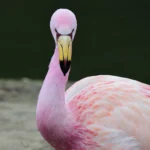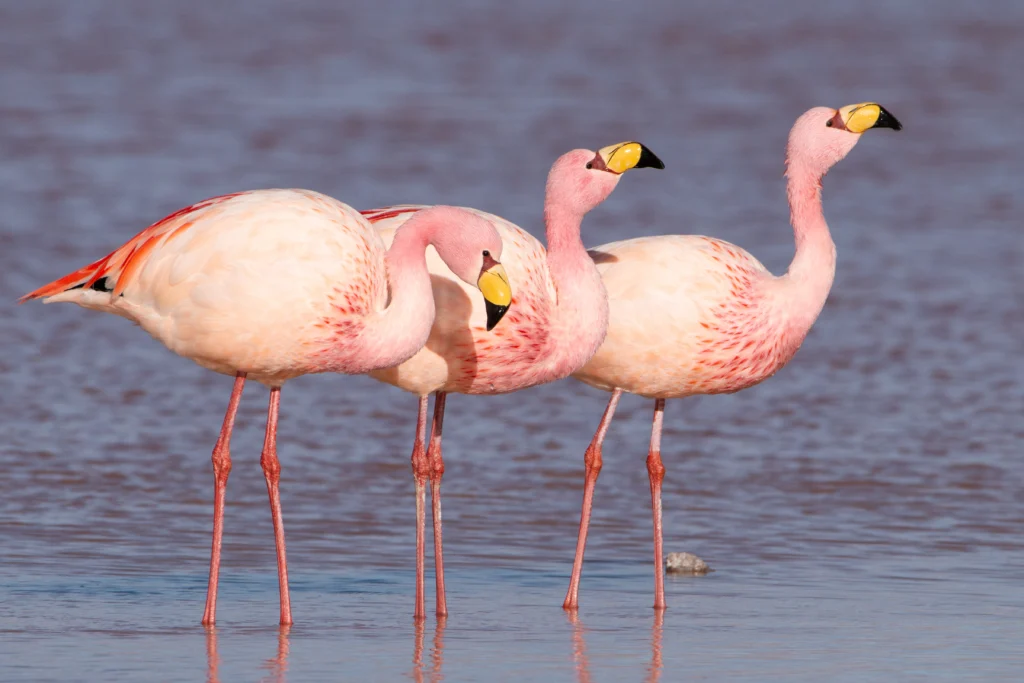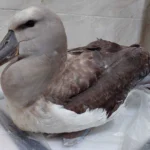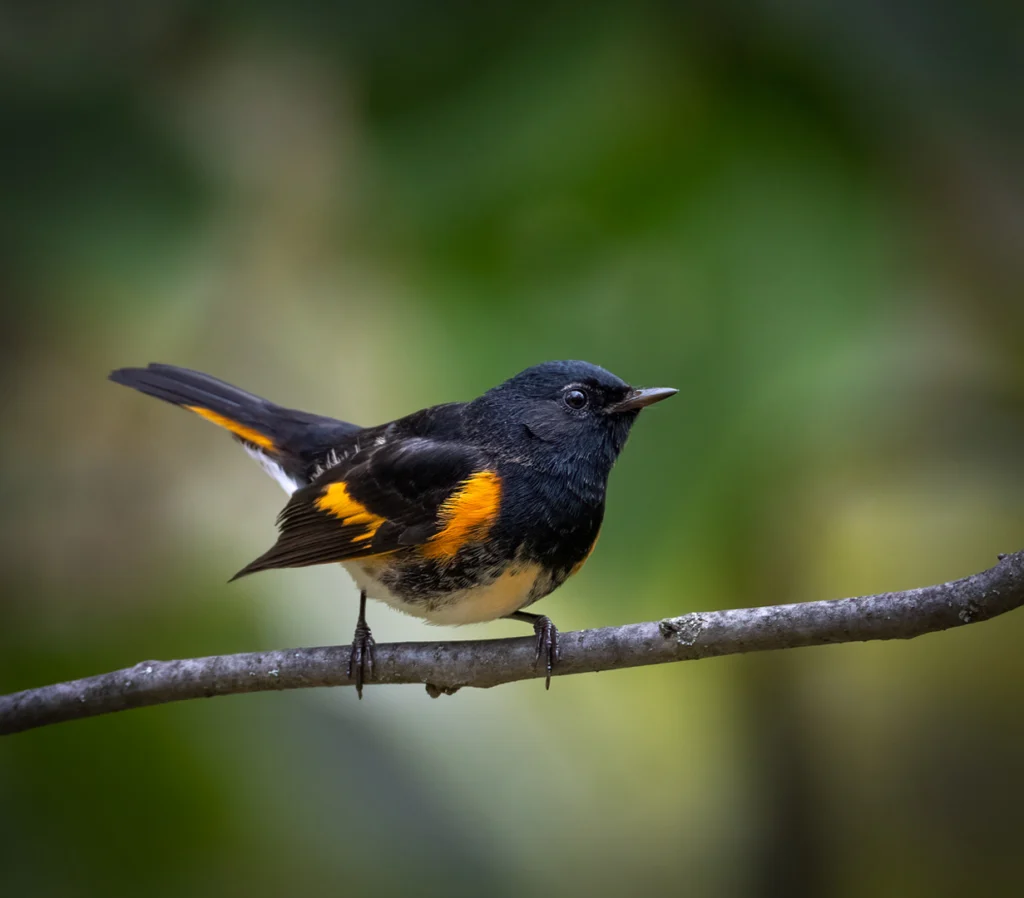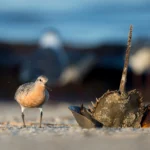
Overview
About
A flock of pink flamingos atop a mountain sounds like some sort of dream … After all, don’t these long-legged wading birds live in low-lying wetlands, like the American Flamingo?
Incredibly, there are three flamingo species that make their homes high in the Andes Mountains of South America: the Andean, Chilean, and James’s Flamingos. The James’s Flamingo is the smallest and rarest of these, and was first described to science from Chile in 1886. Also known as the Puna Flamingo in recognition of its high-altitude habitat, the James’s Flamingo was thought to be extinct for several decades, with no observations by ornithologists after 1924 until 1957, when the species was found breeding at a site in Bolivia. Though the James’s Flamingo population numbers more than 100,000 individuals today, it is considered Near Threatened by the International Union for Conservation of Nature (IUCN) because of its limited range.
Threats
Birds around the world are declining, and many of them are facing ever more urgent threats. But all birds, from rare and local species such as the James’s Flamingo to familiar backyard birds, are made more vulnerable by the cumulative impacts of threats like habitat loss and harmful pesticides.
Habitat Loss
The biggest threat to the James’s Flamingo is habitat loss caused by mining operations, which use large amounts of water. Road construction to access these mines also enables increased development around once-pristine lakes and wetlands.
Climate Change
Climate change can affect water levels in high-altitude lakes and wetlands, which could reduce the number of suitable breeding sites for this flamingo. Climate change will also affect the abundance of diatoms, a microalgae that is one of the James’s Flamingo’s main food sources.
Pesticides & Toxins
Agricultural expansion has been increasing on lands near high Andean lakes. These activities expose the James’s Flamingo and other highland flamingo species to toxic runoff from chemical fertilizers and other pollutants.
Wind Turbines
James’s Flamingos risk fatal collision or electrocution with powerlines near their nesting or stopover sites. This species has also perished in collisions with fences.
Conservation Strategies & Projects
Birds need our help to overcome the threats they face. At ABC, we’re inspired by the wonder of birds and driven by our responsibility to find solutions to meet their greatest challenges. With science as our foundation, and with inclusion and partnership at the heart of all we do, we take bold action for birds across the Americas.
Creating & Maintaining Reserves
ABC has partnered with fellow nonprofit Aves Argentina to create and expand a national park that protects the Laguna Mar Chiquita — a large salt lake in northern Argentina used by James’s, Chilean, and Andean Flamingos.
Rethinking Wind Turbines
ABC provides online resources to learn more about how bird lovers, tower operators, and engineers can create a safer environment for birds by reducing communication tower collisions and fatalities.
Avoiding Pesticides & Toxins
ABC continues to advocate against the widespread use of systemic, water-soluble insecticides such as neonicotinoids. We are beginning to see new progress made in protecting birds and other wildlife from these harmful pesticides.
Bird Gallery
The James’s Flamingo is pale whitish-pink, with a darker pink head and crimson streaking on the chest and back. These colors become more intense during the bird’s breeding season, when it also grows ornamental red scapular (shoulder) plumes that reach from the back to the bird’s tail. Its black flight feathers and red axillaries (wing pits) are most visible in flight.
Male and female James’s Flamingos look alike. Juveniles are whitish-gray with black streaking, and gradually attain adult plumage by their third year of age.
Unique identification features of the James’s Flamingo that distinguish it from other High Andes flamingos include brick-red legs and feet that lack a hind toe, a short, bright yellow, black-tipped bill, and crimson feathering around the eye.

Sounds
The James’s Flamingo gives a variety of high-pitched, nasal honking calls. One vocalization, described as chu-ru-ru or choo-roo-roo, is also a local nickname for this bird.
Andrew Spencer, XC146925. Accessible at www.xeno-canto.org/146925.
Credit: Peter Boesman, XC272896.
Andrew Spencer, XC146926.
Habitat
The James’s Flamingo frequents shallow saline lakes and wetlands in all seasons. It is typically found 7,500 to 16,000 feet above sea level in the Andean dry Puna ecoregion, a high-elevation montane grassland.
- Frequents playa lakes, temporary wetlands in high-altitude, arid regions where water accumulates after rainfall and runoff
- Uses permanent saline or brackish high-altitude lakes with soft clay or sand bottoms
- May move to lower-altitude wetlands, or more rarely, the coast during the nonbreeding season

Range & Region
Range & Region
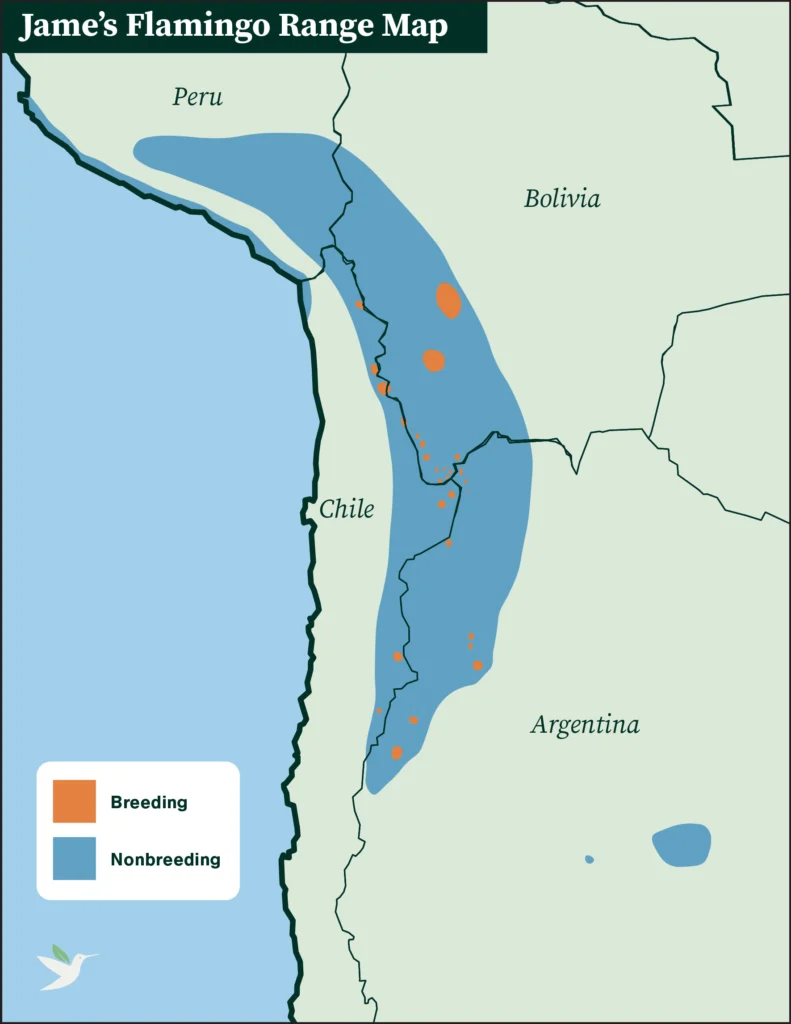
Specific Area
The Andes of southern Peru, southwestern Bolivia, northern Chile, and northwestern Argentina; small numbers also occur in coastal wetlands of Peru and Chile
Range Detail
The James’s Flamingo has a restricted distribution. It breeds in the Andean altiplano (high plateau) within the central Andean dry Puna ecoregion, a habitat characterized by salt flats, dry grasslands and shrublands, and extremely cold temperatures. In the nonbreeding season, when lakes freeze up, this flamingo migrates to shallow wetlands at lower altitudes.
Did you know?
Due to its small size, the James’s Flamingo prefers shallower water than other Andean flamingo species. It also occurs at higher elevations, up to 16,000 feet above sea level.
Life History
The James’s Flamingo begins to breed in the austral spring (November) with the nesting season extending through February. Its breeding success is directly affected by suitable rainfall and water levels. It nests in large colonies, often mixed with Andean and Chilean Flamingos.

Diet
The oddly-shaped beak of the James’s Flamingo is specialized for filter feeding, lined with tiny, hair-like ridges known as lamellae that strain out food items from the water and mud. This bird forages by walking slowly through the shallows, submerging its bill upside-down into the water to stir up bottom sediment and filter out diatoms, phytoplankton, and blue-green algae, its main foods.
Courtship
James’s Flamingos are monogamous and form long-term pair bonds, initiated within their breeding colonies during group displays known as wedding or marching dances. During these noisy, complex displays, large groups of males march and turn as one, while head-flagging (simultaneously stretching their necks upward and turning their heads back and forth) and wing-saluting (flapping their wings). These displays also include beak chattering and other vocalizations to attract the attention of female groups, who may respond with their own displays.
Nesting
Both members of a James’s Flamingo pair use their bills to build a cone-shaped mud nest, mixing in small rocks and plant material if available. The nest has a shallow depression on top for their single egg. The pair may continue to build after their egg is laid in order to raise the height of the nest.
Eggs & Young
The female James’s Flamingo lays a single white egg, which she and her partner take turns incubating for roughly a month. Their chick hatches covered in whitish down and develops a second coat of dark gray down on the upperparts. Its bill is initially straight, only developing into the characteristic flamingo shape after several months.
The parent flamingos take turns brooding their chick and feeding it with regurgitated “crop milk,” a high-fat, nutritious red liquid produced in the adults’ crops. A few other bird families, including pigeons and doves such as the Mourning Dove, feed their chicks in this way.
The young flamingo leaves the nest about 30 to 50 days after hatching and joins other flamingo chicks in a large group known as a crèche. Parents continue to feed their chick, locating it by voice within the crèche, until its bill grows into its final downcurved shape, meaning that the juvenile bird can finally feed itself.

